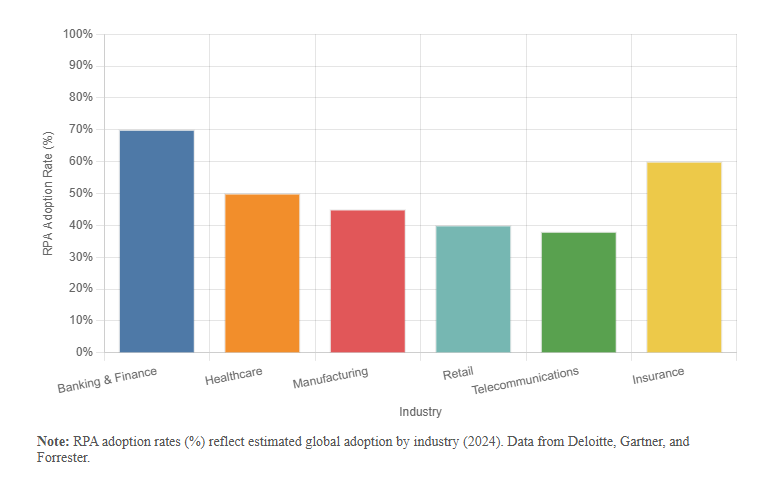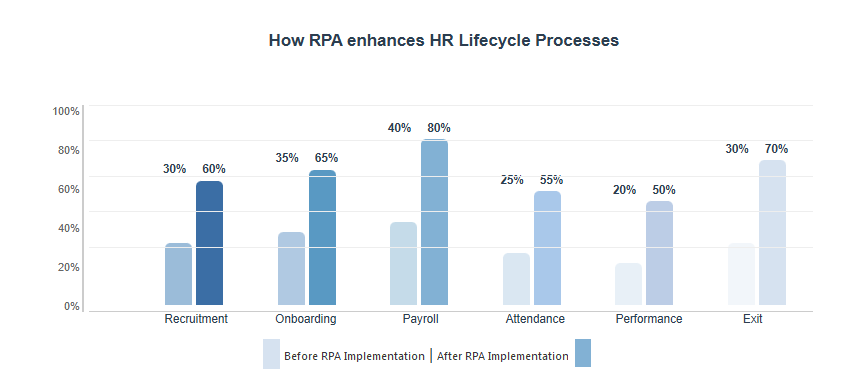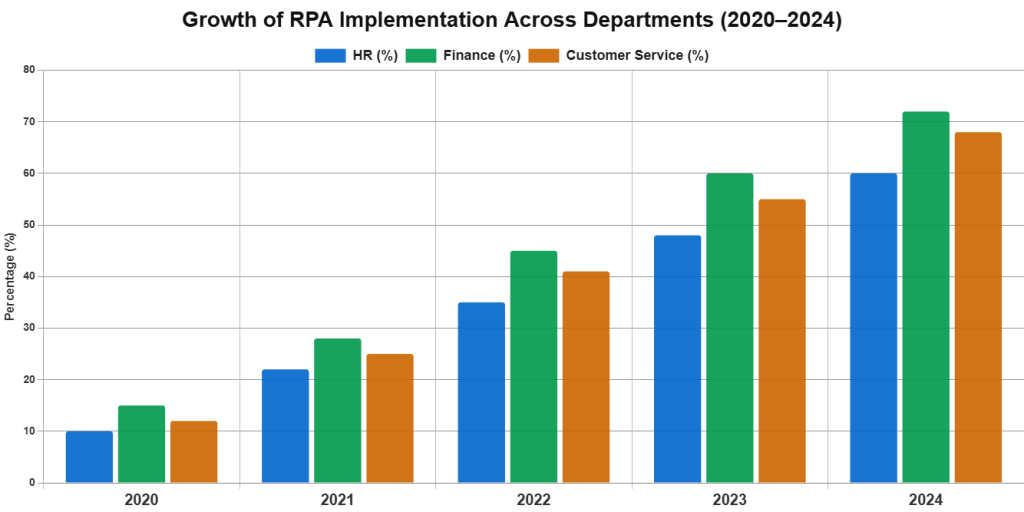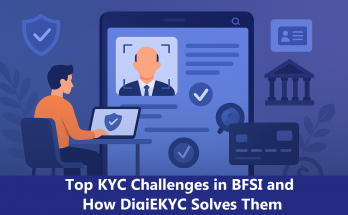As organisations navigate increasing operational demands and cost constraints, the focus on process efficiency has become more critical than ever. Across key business functions such as Human Resources, Finance, and Customer Service, manual and repetitive tasks continue to hinder productivity, delay decision-making, and affect service quality.
Robotic Process Automation (RPA) has emerged as a strategic solution to these challenges. Designed to handle high-volume, rule-based tasks, RPA enables businesses to streamline operations, reduce errors, and allocate human resources to more value-driven activities. Its scalability and cost-effectiveness make it particularly relevant in today’s fast-paced business environment.
Wondering where RPA fits into your workflow? Let’s audit and find out.
Why Modern Businesses are Turning to RPA
Robotic Process Automation (RPA) is no longer viewed as a short-term fix for operational inefficiencies—it is now recognized as a key enabler of enterprise-wide transformation. Its strength lies in its ability to drive efficiency without disrupting existing IT ecosystems. This low-disruption approach allows IT teams to implement RPA-driven automation without going through costly and time-consuming system overhaul.
Another significant advantage of RPA is its ability to operate around the clock with consistent precision. Unlike manual processes that are prone to fatigue, human error, and inconsistent throughput, software bots can execute repetitive, rule-based tasks 24/7—delivering dependable results at scale. This makes RPA particularly suitable for high-volume functions such as HR operations, payroll processing, accounts payable, and customer service ticketing, where reliability and speed are essential.
RPA is not just a productivity tool, it’s a gateway to building a future-ready enterprise.
— Forrester Research
In addition to enhancing speed and accuracy, RPA also brings tangible strategic value to diverse business functions:
- Accelerated ROI: Most RPA initiatives demonstrate a measurable return on investment within 6 to 9 months, making it one of the most cost-effective digital solutions available today.
- Compliance Assurance: With built-in capabilities for detailed logging and audit trails, RPA ensures that every action is traceable with well-facilitated regulatory compliance and risk mitigation.
- Enhanced Workforce Productivity: By automating mundane, repetitive tasks, RPA frees up employee time for higher-value activities, resulting in greater job satisfaction and improved focus on strategic goals.
As organisations continue to pursue agility and resilience, RPA plays a pivotal role—not only in optimizing processes but also in laying the foundation for broader digital transformation initiatives.

How RPA Streamlines the Entire HR Lifecycle
Human Resources, while central to workforce development and organisational culture, continues to face operational strain from process-heavy responsibilities. From recruitment logistics to employee exits, HR teams are often bogged down by administrative routines that divert attention from strategic priorities. Robotic Process Automation (RPA) addresses this challenge by digitising and streamlining key functions across the employee lifecycle, resulting in faster execution, improved accuracy, and better service delivery.
Practical RPA Applications Across HR Functions
- Recruitment and Candidate Evaluation
RPA expedites early-stage hiring tasks such as resume parsing, candidate profiling, and background verification. Automated filtering mechanisms reduce manual shortlisting time, ensuring that hiring teams can focus on assessing potential rather than managing paperwork. - Onboarding Enablement
The complexity of onboarding extends beyond HR and involves multiple touchpoints across departments. RPA coordinates these tasks—automating the issuance of offer letters, triggering account provisioning, initiating document workflows, and scheduling orientation activities—creating a unified, timely onboarding experience. - Workforce Transactions and Records Management
Payroll, benefits administration, and attendance reconciliation are highly transactional and rule-based. RPA ensures precise data validation, seamless calculations, and integration with payroll systems. This minimises processing delays, mitigates compliance risks, and enhances consistency across records. - Exit and Separation Handling
Employee separation involves meticulous steps to ensure policy compliance and financial accuracy. RPA enables structured offboarding by automating clearance forms, final settlements, asset tracking, and the closure of internal accounts, maintaining both efficiency and accountability.
Quantifiable Outcomes of RPA Integration into HR Functions
Organisations adopting RPA within HR operations can realise significant performance gains by automating rule-based, high-volume processes. RPA acts as a digital workforce, executing repetitive tasks with speed, accuracy, and consistency. Here’s how it delivers measurable impact across core HR functions:
- Onboarding cycles can be shortened by up to 70%
RPA bots streamline onboarding by automating tasks like document collection, background checks, access provisioning, and welcome emails through HRMS integration. This accelerates new hire readiness, improves process uniformity, and enhances the first-day experience for employees. - Payroll discrepancies and compliance issues can be significantly reduced
With bots automatically validating inputs from attendance, timesheets, and leave management systems, payroll processing becomes more accurate and timely. RPA enforces predefined rules consistently, minimising compliance risks and reducing the burden of post-payroll adjustments or audits. - Annual HR bandwidth savings can reach up to 40%
Routine tasks such as employee data updates, document generation, and status tracking can be offloaded to RPA, freeing HR teams to redirect their time toward talent strategy, employee development, and culture-building initiatives. - Scalability without proportional resource increase
As organisations grow, RPA scales easily to handle increased volumes of transactions, such as hiring surges or benefits enrollments, without the need for additional human resources. Bots can operate 24/7 and handle peaks in workload with no decline in performance. - Improved audit readiness and data accuracy
Every action performed by an RPA bot is logged in detail, offering complete traceability and transparency. This facilitates easier audits, reduces documentation gaps, and strengthens data integrity across HR operations. - Enhanced employee experience through faster service delivery
Employees benefit from quicker turnaround times on common requests, such as payslips, address changes, or policy access, thanks to automated service desk integrations. This responsiveness improves internal satisfaction and trust in HR services.
With the shift toward employee-centric HR models, automation plays a vital role in enhancing service quality while relieving teams of repetitive operational overhead. RPA not only accelerates processes—it reinforces HR’s role as a value-driving function within the enterprise.

How RPA-driven Automation Transforms Financial Workflows
Finance functions are under increasing pressure to operate with agility, maintain regulatory compliance, and deliver data-driven insights—often with limited resources. However, the volume and complexity of financial transactions make manual processing both time-consuming and prone to error. Robotic Process Automation (RPA) offers a practical and scalable solution by standardising financial workflows, enhancing transparency, and enabling faster decision-making without compromising on control.
Key Use Cases in Financial Automation
- Invoice and Procurement Processing
Bots can automatically match invoices to purchase orders, flag discrepancies, validate payment terms, and reconcile vendor accounts—significantly reducing cycle times and minimising errors in accounts payable operations. - Expense Management and Tax Handling
RPA streamlines claim verification, enforces policy compliance, and automates tax calculations, ensuring accurate reimbursements and adherence to statutory obligations with minimal manual oversight. - Forecasting and Financial Closures
Automation facilitates structured data aggregation and validation, accelerating monthly, quarterly, and annual closures. It also supports budget forecasting by integrating data from multiple systems for more reliable financial planning. - Compliance, Reporting, and Audits
RPA enables consistent, rule-based generation of regulatory reports and internal audit documentation. It supports SOX compliance and other governance frameworks by maintaining detailed logs and ensuring procedural integrity.
According to Deloitte, finance departments leveraging RPA report operational cost reductions ranging from 25% to 50%.
Value Delivered Through Intelligent Automation
- Real-time transaction tracking for greater visibility and control over financial operations
- Enhanced compliance posture, with standardised workflows and complete audit trails
- Up to 3x faster financial closures for enabling leadership to act on insights without delay
As finance evolves from a transactional backbone to a strategic business partner, RPA is a vital tool, offering precision, speed, and control at scale. Its adoption not only reduces operational load but also strengthens financial resilience across the enterprise.
Role RPA Plays in Building Consistent Customer Journeys
In an era where customer expectations are shaped by speed, personalisation, and consistency, service teams face mounting pressure to deliver high-quality support across multiple channels. Traditional customer service models often struggle to keep pace due to fragmented systems, repetitive inquiries, and high volumes. Robotic Process Automation (RPA), when integrated into customer experience (CX) frameworks, brings a new level of responsiveness, efficiency, and consistency, enabling organisations to scale support without scaling cost.
Key Use Cases: How RPA Enhances CX Operations
- Intelligent Ticket Triage and Routing
RPA bots can automatically classify incoming queries based on topic, urgency, or customer history, and route them to the appropriate team or system. This reduces manual sorting, ensures priority handling, and shortens initial response times. - Real-Time CRM and Order Management
Bots can retrieve and update customer data, check order status, and initiate refunds by integrating directly with backend systems. This empowers service teams with up-to-date information and reduces the need for customers to repeat themselves. - AI-Integrated Assistance for First-Level Support
Combining RPA with conversational AI enables automated responses to frequently asked questions and intelligent ticket escalation, offloading volume from human agents while maintaining a consistent experience. - SLA Monitoring and Compliance Enforcement
Automation supports proactive monitoring of service-level commitments. Bots can track resolution timelines, trigger escalation workflows for overdue tickets, and ensure compliance with contractual obligations.
McKinsey reports that enterprises deploying RPA in customer service functions see up to a 30% improvement in response time and customer satisfaction.
Value Delivered Across the Customer Lifecycle
- Significant reduction in average resolution time, often shrinking response cycles from hours to minutes
- Consistent quality of service across channels, languages, and geographies
- Greater agent productivity, as repetitive inquiries are handled by bots, freeing up human teams for complex or emotionally nuanced issues
RPA enhances the foundation of service excellence—not by replacing human interaction, but by reinforcing it. Automating high-frequency, low-complexity tasks makes customer service functions faster, more agile, and better equipped to meet growing expectations.
Leveraging RPA to Eliminate Workflow Gaps with Cross-Functional Automation
Robotic Process Automation (RPA) streamlines business operations by automating repetitive tasks across departments. RPA eliminates operational silos and workflow gaps by automating real-time data synchronization across finance, HR, supply chain, and customer service functions. This operational consistency minimises manual intervention, accelerates decision-making, and reduces compliance risks, driving cost savings, improving agility, and enabling scalable growth.
Here are some key ways RPA transforms cross-functional operations:
- Seamless Interdepartmental Data Flow
RPA bridges disparate systems by transferring data between HR, finance, customer service, and IT with speed and accuracy. This reduces handoff delays, eliminates manual entry redundancies, and ensures data consistency throughout the enterprise. - Better Cross-Department Coordination
Rather than automating isolated tasks, organisations can deploy RPA to coordinate entire workflows. For example, an employee onboarding process spans HR (hiring and documentation), finance (payroll initiation), and IT (asset provisioning). RPA can manage this end-to-end sequence, triggering the right actions at the right time with minimal human oversight. - Integrated Analytics and Reporting
When bots operate across multiple functions, they generate data that can be centrally analysed to derive business insights. This enables better visibility into process performance, compliance adherence, and operational risks, supporting informed, timely decision-making at the leadership level. - Scalable Foundation for Intelligent Automation
Enterprise-wide RPA lays the groundwork for more advanced digital initiatives. By standardising workflows and centralising data, RPA creates a foundation for AI-enabled decision-making, predictive analytics, and intelligent document processing, helping organisations move toward true cognitive automation.
Departmental RPA Adoption Growth (2020-2024): RPA adoption for HR automation followed by Finance and then Customer Service. Source: Deloitte, Gartner, Forrester.”
Tech Anand Rathi: An Industry Leader in RPA and Hyperautomation Solutions
Robotic Process Automation is delivering tangible results across key business functions. HR teams are freed from routine tasks to focus on strategic initiatives. Finance departments gain agility through faster, more accurate processes. Customer service operations improve by enabling staff to engage in more meaningful interactions.
As RPA and hyperautomation become central to modern enterprise strategy, choosing the right partner is critical. Tech Anand Rathi, a trusted RPA and hyperautomation service provider, brings the experience, frameworks, and technology needed to turn automation goals into measurable outcomes.
Looking to streamline your workflows with robotic intelligence?
Start your RPA-driven transformation with Tech Anand Rathi today.



